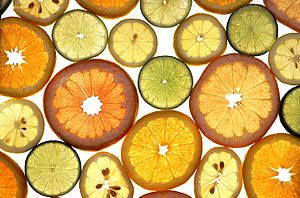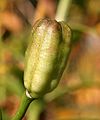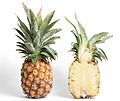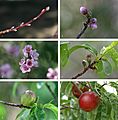Fruit facts for kids
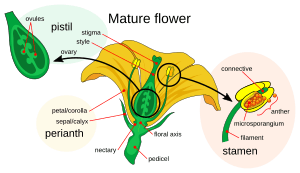
In the world of botany (the study of plants), a fruit is a special part of a plant that holds its seeds. For scientists who study plants, a fruit is only called a fruit if it grows from the ovary of a flower. Think of the ovary as the part of the flower that contains the tiny beginnings of seeds.
Fruits often have an extra layer around the seeds. This layer can be soft and juicy, like in a peach, or dry and hard, like in a nut. Even botanists sometimes disagree on how to sort fruits into different groups!
When we talk about fruits in everyday life, especially when we're cooking, we usually mean something sweet and juicy. But many things we call vegetables, like tomatoes or cucumbers, are actually fruits to a botanist! On this page, we'll explore what botanists mean when they say "fruit."
The soft, fleshy part of a fruit that we often eat is called the mesocarp. It's found between the fruit's skin (the exocarp) and the seeds. For example, the white, crunchy part of an apple is its fleshy mesocarp.
Contents
Types of Fruits
There are many different kinds of fruits, and botanists have special names for them based on how they grow and what they look like.
Berry
A berry is a fruit where the entire thing is soft and fleshy, except for a thin skin on the outside. Berries can have one seed or many. Think of grapes, avocados, and blueberries – they all have thin skins and are mostly soft inside. But here's a fun fact: strawberries are actually not true berries! That's because their seeds are on the outside, while a real berry must have its seeds inside.
Pepo
A pepo (say: PEE-poh) is a special kind of berry. It has a very hard and thick skin, which we usually call a "rind." Good examples of pepos are Pumpkins and watermelons.
Hesperidium
A hesperidium (say: hess-per-ID-ee-um) is another type of berry that has been changed. It has a leathery skin that isn't as hard as a pepo's rind. All citrus fruits, such as oranges and lemons, are hesperidiums.
Pome
A pome (say: POHM) is a fruit with a core in the middle. This core is surrounded by the fleshy part that we eat. We usually don't eat the core itself. Apples and pears are classic examples of pomes. Berries are different because their seeds are mixed within the fleshy part, not separated by a core.
Drupe
Drupes are also known as stone fruits. A drupe is a fleshy fruit that has a single, hard "stone" or "pit" around its seed. Peaches and olives are great examples of drupes. Did you know that an almond is also a drupe? We eat the seed that's inside its hard pit!
What Botanists Call Fruits
Since fruits grow from the fertilized ovaries of flowers, only flowering plants can make fruits. Fruits are a clever way that plants have developed to help their seeds spread around, often with the help of animals.
The botanical definition of a fruit includes many things we don't usually think of as "fruits" in our kitchens. For example, many vegetables are actually botanical fruits! These include squash and pumpkins, cucumbers, tomatoes, peas, beans, corn, eggplant, and sweet peppers. Even some spices, like allspice and chillies, are botanically fruits.
Accessory Fruits
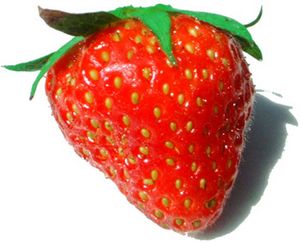
An accessory fruit, sometimes called a false fruit, is a fruit where some of the fleshy part comes from other parts of the flower, not just the ovary.
For example, a fig is an accessory fruit. Pomes like apples and pears are also accessory fruits. In these, the core is the true fruit, and the juicy part we eat comes from other flower tissues.
Things That Look Like Fruits But Aren't
Some things might look like fruits but are not considered botanical fruits:
- Things produced by plants that don't flower, like juniper berries. These are actually the seed-holding cones of conifer trees.
- Fleshy, fruit-like growths that come from other plant parts, not the flower's ovary (like rhubarb).
Common Fruits That Are Also Botanical Fruits

Here are some fruits you can buy in shops that are also considered true botanical fruits:
- True berries: redcurrants, gooseberries, cranberries, blueberries. Also, though not commonly called berries, tomatoes, avocados, and bananas are botanically berries!
- False berries: blackberries, strawberries, raspberries. These are called "aggregate fruits" because they form from many tiny ovaries in one flower. The yew berry is not a fruit at all because yew is a conifer, not a flowering plant.
- Stone fruits (drupes): plums, cherries, peaches, apricots, olives.
- Citrus fruits: like oranges, grapefruits, and tangerines.
- Aggregate fruits: raspberries, blackberries.
- Multiple fruits: pineapples, figs.
Many fruits grow on trees or bushes. For plants, fruits are a way to spread their seeds, usually with the help of animals. When an animal eats a fruit, the seeds can pass through its body and be dropped in a new place, where they can grow.
Most fruits we eat contain a lot of water and natural sugars. Many are also high in Vitamin C and have a good amount of dietary fibre. Fruits are usually low in protein and fat, but avocados and some nuts are exceptions. Not just humans, but many other animals like primates, mammals, and birds love to eat fruits!
Seedless Fruits
Some fruits we buy are special because they don't have seeds. This is a very useful feature for fruits sold in stores! Think of seedless bananas, pineapples, and some watermelons. Many citrus fruits, especially oranges, satsumas, mandarin oranges, and grapefruits, are also popular because they are seedless.
Seedless bananas and grapes are often "triploids." This means they have three sets of chromosomes instead of the usual two. Their seedlessness happens because the tiny plant inside the seed (the embryo) doesn't develop properly, even after the flower is pollinated and fertilized.
See also
Images for kids
-
Various culinary fruits
-
Caraway fruits. Many people mistakenly call these "seeds."
-
A Pomegranate, showing its outer skin (right) and the seeds with their edible juicy covering (left).
-
Dewberry flowers. Notice the many tiny pistils, each of which will form a small drupelet. The whole flower will become a blackberry-like aggregate fruit.
-
A dry simple fruit: milkweed (Asclepias syriaca). When the follicular fruit opens, it shows the seeds inside.
-
A strawberry, showing the tiny "seeds" (achenes) on its surface. Botanically, strawberries are not true berries; they are an aggregate accessory fruit.
-
A flower of Magnolia × wieseneri showing the many pistils that make up the gynoecium in the center. The fruit of this flower is a cluster of follicles.
-
An unripe capsule fruit from a Lilium plant; it's an aggregate fruit.
-
The fruit of a pineapple includes tissue from the sepals as well as the pistils of many flowers. It is a multiple-accessory fruit.
-
This chart compares fresh fruits for fiber, potassium (K), and vitamin C. Each dot shows the amount in a 100 gram serving of the fruit. The size of the dot shows the amount of fiber. Vitamin C is on the bottom axis, and potassium is on the side axis. Bananas are high in fiber and potassium, and oranges are high in fiber and vitamin C.
-
Porcelain vine is often planted for its colorful berries.
-
In the noni plant, flowers grow in a line along the stem. You can see flowers, developing fruits, and ripening fruits all at once.
See also
 In Spanish: Fruta para niños
In Spanish: Fruta para niños



